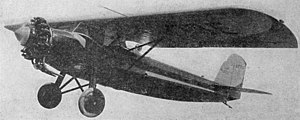| Moreland M-1 | |
|---|---|

| |
| Role | Three-seat light sports and transport biplaneType of aircraft |
| National origin | United States |
| Manufacturer | Moreland Aircraft Inc. |
| First flight | 1929 |
| Number built | 4 |
The Moreland M-1 was a 1929 American three-seat civil aircraft. Only four were built.
Design and development
The M-1 was the first aircraft built by Moreland aircraft, founded in 1928 and based at El Segundo, California. Led by G.E.Moreland and Orrin Moe, the design also contained Ed Heinemann's first contributions. It was a parasol wing aircraft with wings of rectangular plan apart from rounded tips and a central, trailing edge cut-out to enhance the pilot's field of view. They had wooden structures with spruce box-spars and ribs, were plywood-covered and braced to the fuselage by pairs of outward-leaning N-form struts between the mid- and lower longerons and the wing spars. These struts were quite short, reaching the wings at about 25% span. A cabane provided central wing support.
The M-1's nine cylinder Wright J-5 Whirlwind radial engine was nose-mounted, flown with or without a ring type engine cowling. The fuselage of the M-1 had a welded chrome-molybdenum steel tube structure, like many designs of the time, and was fabric-covered. Zips provided easy access to the rear control connections. Two passengers sat side-by-side close to the wing underside at about mid-chord. They were protected by a large, V-shaped windscreen which projected forward of the leading edge to the engine mounting and rearwards to the hinge of a large access door. The pilot's well-instrumented cockpit was under the trailing edge cut-out, providing views both above and below the wing.
The M-1's vertical rear control surfaces were rather straight and upright, though the balanced rudder was round-tipped. Its tailplane, mounted on top of the fuselage, was adjustable and wire-braced to the fin.
The undercarriage was a split axle design, with the axles hinged from the fuselage central underside. Near-vertical Aerol shock absorber legs were fuselage-mounted at the base of the forward wing struts and drag struts reached rearwards to the lower fuselage.
Operational history
The M-1 first flew in 1929, though the exact date is not known, and received its type certificate in September. It featured at the Cleveland Air Show held in the autumn of 1929. Only four were built.
Specifications
Data from Aero Digest (September 1929) except where noted
General characteristics
- Crew: one
- Capacity: two passengers
- Length: 26 ft 6 in (8.08 m)
- Wingspan: 39 ft (12 m)
- Height: 8 ft 9 in (2.67 m)
- Wing area: 260 sq ft (24 m) including ailerons
- Empty weight: 1,750 lb (794 kg)
- Gross weight: 2,750 lb (1,247 kg)
- Fuel capacity: 70 US gal (58 imp gal; 260 L)
- Powerplant: 1 × Wright J-5 Whirlwind nine cylinder radial, 225 hp (168 kW) at 1,800 rpm
- Propellers: 2-bladed
Performance
- Maximum speed: 132 mph (212 km/h, 115 kn)
- Cruise speed: 115 mph (185 km/h, 100 kn)
- Landing speed: 40 mph (64 km/h; 35 kn)
- Range: 650 mi (1,050 km, 560 nmi)
- Service ceiling: 17,800 ft (5,400 m) ; absolute ceiling 20,000 ft (6,100 m)
- Rate of climb: 1,000 ft/min (5.1 m/s) initial
References
- ^ "Aerofiles: Moreland". Retrieved 20 May 2020.
- Gunston, Bill (1993). World Encyclopaedia of Aircraft Manufacturers: from the pioneers to the present day. Sparkford, Somerset: Patrick Stephens Limited. p. 211. ISBN 9 781852 602055.
- ^ Horsefall, J.E., ed. (August 1929). "Moreland Monoplane". Aero Digest. Vol. 15, no. 2. New York City: Aeronautical Digest Publishing Corp. p. 146.
- Horsefall, J.E., ed. (September 1929). "Recent approved type certificates". Aero Digest. Vol. 15, no. 3. New York City: Aeronautical Digest Publishing Corp. p. 220.
- Horsefall, J.E., ed. (September 1929). "Exhibitors at the Cleveland Air Show". Aero Digest. Vol. 15, no. 3. New York City: Aeronautical Digest Publishing Corp. p. 118.